Optimizing the Knowledge on Residential Heating Characteristics in Greece via Crowd-Sourcing Approach
Abstract
1. Introduction
2. Materials and Methods
2.1. Energy Consumption
2.2. Crowdsourcing Data Collection
2.3. Emissions Spatial and Temporal Distribution Methodology
3. Results and Discussion
3.1. National Emissions Analysis
3.2. Key Findings from the Online Survey
3.3. Regional Missions
3.4. Gridded and Temporarily Distributed Emissions
4. Conclusions
Supplementary Materials
Author Contributions
Funding
Institutional Review Board Statement
Informed Consent Statement
Data Availability Statement
Conflicts of Interest
References
- Nejat, P.; Jomehzadeh, F.; Taheri, M.M.; Gohari, M.; Muhd, M.Z. A global review of energy consumption, CO2 emissions and policy in the residential sector (with an overview of the top ten CO2 emitting countries). Renew. Sustain. Energy Rev. 2015, 43, 843–862. [Google Scholar] [CrossRef]
- United Nations. Emissions Gap Emissions Gap Report 2020; United Nations Environmental Programme: Nairobi, Kenya, 2020. [Google Scholar]
- Khzouz, M.; Gkanas, E.I.; Shao, J.; Sher, F.; Beherskyi, D.; El-Kharouf, A.; Qubeissi, M.A. Life Cycle Costing Analysis: Tools and Applications for Determining Hydrogen Production Cost for Fuel Cell Vehicle Technology. Energies 2020, 13, 3783. [Google Scholar] [CrossRef]
- Yaqoob, H.; Teoh, Y.H.; Goraya, T.S.; Sher, F.; Jamil, M.A.; Rashid, T.; Yar, K.A. Energy evaluation and environmental impact assessment of transportation fuels in Pakistan. Case Stud. Chem. Environ. Eng. 2021, 3, 100081. [Google Scholar] [CrossRef]
- Adeniyi, A.G.; Otoikhian, K.S.; Ighalo, J.O. Steam Reforming of Biomass Pyrolysis Oil: A Review. Int. J. Chem. React. Eng. 2019, 17, 20180328. [Google Scholar] [CrossRef]
- Yin, C.; Qiu, S.; Zhang, S.; Sher, F.; Zhang, H.; Xu, J.; Wen, L. Strength degradation mechanism of iron coke prepared by mixed coal and Fe2O3. J. Anal. Appl. Pyrolysis 2020, 150, 104897. [Google Scholar] [CrossRef]
- Zahid, I.; Ayoub, M.; Abdullah, B.B.; Nazir, M.H.; Zulqarnain; Kaimkhani, M.A.; Sher, F. Activation of nano kaolin clay for bio-glycerol conversion to a valuable fuel additive. Sustainability 2021, 13, 2631. [Google Scholar] [CrossRef]
- Sher, F.; Yaqoob, A.; Saeed, F.; Zhang, S.; Jahan, Z.; Klemeš, J.J. Torrefied biomass fuels as a renewable alternative to coal in co-firing for power generation. Energy 2020, 209, 118444. [Google Scholar] [CrossRef]
- Liu, L.; Qu, J.; Maraseni, T.N.; Niu, Y.; Zeng, J.; Zhang, L.; Xu, L. Household CO2 Emissions: Current Status and Future Perspectives. Int. J. Environ. Res. Puplic Health 2020, 17, 7077. [Google Scholar] [CrossRef] [PubMed]
- Ramacher, M.O.P.; Matthias, V.; Aulinger, A.; Quante, M.; Bieser, J.; Karl, M. Contributions of traffic and shipping emissions to city-scale NOx and PM2.5 exposure in Hamburg. Atmos. Environ. 2020, 237, 117674. [Google Scholar] [CrossRef]
- Vedrenne, M.; Borge, R.; Lumbreras, J.; Rodríguez, M.E.; de la Paz, D.; Pérez, J.; Manuel de Andrés, J.; Quaassdorff, C. A comprehensive approach for the evaluation and comparison of emission inventories in Madrid. Atmos. Environ. 2016, 145, 29–44. [Google Scholar] [CrossRef]
- Georgiou, G.K.; Kushta, J.; Christoudias, T.; Proestos, Y.; Lelieveld, J. Air quality modelling over the Eastern Mediterranean: Seasonal sensitivity to anthropogenic emissions. Atmos. Environ. 2020, 222, 117–119. [Google Scholar] [CrossRef]
- Saffari, A.; Daher, N.; Samara, C.; Voutsa, D.; Kouras, A.; Manoli, E.; Karagkiozidou, O.; Vlachokostas, C.; Moussiopoulos, N.; Shafer, M.M.; et al. Increased biomass burning due to the economic crisis in Greece and its adverse impact on wintertime air quality in Thessaloniki. Environ. Sci. Technol. 2013, 47, 13313–13320. [Google Scholar] [CrossRef]
- Papada, L.; Kaliampakos, D. Measuring energy poverty in Greece. Energy Policy 2016, 94, 157–165. [Google Scholar] [CrossRef]
- Fameli, K.-M.; Assimakopoulos, V.D. The new open Flexible Emission Inventory for Greece and the Greater Athens Area (FEI-GREGAA): Account of pollutant sources and their importance from 2006 to 2012. Atmos. Environ. 2016, 137, 17–37. [Google Scholar] [CrossRef]
- Fameli, K.M.; Kotrikla, A.M.; Psanis, C.; Biskos, G.; Polydoropoulou, A. Estimation of the emissions by transport in two port cities of the northeastern Mediterranean, Greece. Environ. Pollut. 2020, 257, 113598. [Google Scholar] [CrossRef] [PubMed]
- López-Aparicio, S.; Vogt, M.; Schneider, P.; Kahila-Tani, M.; Broberg, A. Public participation GIS for improving wood burning emissions from residential heating and urban environmental management. J. Environ. Manag. 2017, 191, 179–188. [Google Scholar] [CrossRef] [PubMed]
- Plejdrup, M.S.; Nielsen, O.-K.; Brandt, J. Spatial emission modelling for residential wood combustion in Denmark. Atmos. Environ. 2016, 144, 389–396. [Google Scholar] [CrossRef]
- Karim, M.R.; Naser, J. Numerical Modelling of Solid Biomass Combustion: Difficulties in Initiating the Fixed Bed Combustion. Energy Procedia 2017, 110, 390–395. [Google Scholar] [CrossRef]
- Savolahti, M.; Karvosenoja, N.; Tissari, J.; Kupiainen, K.; Sippula, O.; Jokiniemi, J. Black carbon and fine particle emissions in Finnish residential wood combustion: Emission projections, reduction measures and the impact of combustion practices. Atmos. Environ. 2016, 140, 495–505. [Google Scholar] [CrossRef]
- Vicente, E.D.; Alves, C.A. An overview of particulate emissions from residential biomass combustion. Atmos. Res. 2018, 199, 159–185. [Google Scholar] [CrossRef]
- Seljeskog, M.; Goile, F.; Skreiberg, O. Recommended Revisions of Norwegian Emission Factors for Wood Stoves. Energy Procedia 2017, 105, 1022–1028. [Google Scholar] [CrossRef]
- Fachinger, F.; Drewnick, F.; Gieré, R.; Borrmann, S. How the user can influence particulate emissions from residential wood and pellet stoves: Emission factors for different fuels and burning conditions. Atmos. Environ. 2017, 158, 216–226. [Google Scholar] [CrossRef]
- Wielgosiński, G.; Łechtańska, P.; Namiecińska, O. Emission of some pollutants from biomass combustion in comparison to hard coal combustion. J. Energy Inst. 2017, 90, 787–796. [Google Scholar] [CrossRef]
- Arabatzis, G.; Kitikidou, K.; Tampakis, S.; Soutsas, K. The fuelwood consumption in a rural area of Greece. Renew. Sustain. Energy Rev. 2012, 16, 6489–6496. [Google Scholar] [CrossRef]
- Santamouris, M.; Paravantis, J.A.; Founda, D.; Kolokotsa, D.; Michalakakou, P.; Papadopoulos, A.M.; Kontoulis, N.; Tzavali, A.; Stigka, E.K.; Ioannidis, Z.; et al. Financial crisis and energy consumption: A household survey in Greece. Energy Build. 2013, 65, 477–487. [Google Scholar] [CrossRef]
- Boemi, S.N.; Papadopoulos, A.M. Monitoring energy poverty in Northern Greece: The energy poverty phenomenon. Int. J. Sustain. Energy 2019, 38, 74–88. [Google Scholar] [CrossRef]
- Karytsas, S.; Polyzou, O.; Karytsas, C. Factors affecting willingness to adopt and willingness to pay for a residential hybrid system that provides heating/cooling and domestic hot water. Renew. Energy 2019, 142, 591–603. [Google Scholar] [CrossRef]
- Zhang, M.; Chen, W.; Shen, X.; Zhao, H.; Gao, C.; Zhang, X.; Liu, W.; Yang, C.; Qin, Y.; Zhang, S.; et al. Comprehensive and high-resolution emission inventory of atmospheric pollutants for the northernmost cities agglomeration of Harbin-Changchun, China: Implications for local atmospheric environment management. J. Environ. Sci. (China) 2021, 104, 150–168. [Google Scholar] [CrossRef]
- EEA. EMEP/EEA Air Pollutant Emission Inventory Guidebook 2019, Technical Guidance to Prepare National Emission Inventories; EEA Report No 13/2019; EEA: København, Denmark, 2019. [Google Scholar]
- HBS. Household Budget Survey 2017. Hellenic Statistical Authority, A0801_SFA05_TB_AN_00_2017_201_F_GR.xlsx, Data.2021. Available online: https://www.statistics.gr/en/statistics/-/publication/SFA05/2017 (accessed on 30 January 2020).
- Lagouvardos, K.; Kotroni, V.; Bezes, A.; Koletsis, I.; Kopania, T.; Lykoudis, S.; Mazarakis, N.; Papagiannaki, K.; Vougioukas, S. The automatic weather stations NOANN network of the National Observatory of Athens: Operation and database. Geosci. Data J. 2017, 4, 4–16. [Google Scholar] [CrossRef]
- Papamanolis, N. The first indications of the effects of the new legislation concerning the energy performance of buildings on renewable energy applications in buildings in Greece. Int. J. Sustain. Built Environ. 2015, 4, 391–399. [Google Scholar] [CrossRef][Green Version]
- Caserini, S.; Marazzi, L.; Crovetto, M.; BallarinDenti, A.; Lapi, M.; Bosco, C.; Fraccaroli, A.; Fossati, G.; Guariso, G.; Gurrieri, G. An extensive survey on wood use for domestic heating in Lombardy: Implication for PM emission inventory. In Proceedings of the 14th International Emission Inventory Conference, Transforming Emission Inventories—Meeting Future Challenges Today, Las Vegas, NV, USA, 11–14 April 2005; US Environmental Protection Agency: Washington, DC, USA, 2005. [Google Scholar]
- DUKES. Digest of United Kingdom Energy Statistics 2015. 2015. Available online: https://assets.publishing.service.gov.uk/government/uploads/system/uploads/attachment_data/file/450302/DUKES_2015.pdf (accessed on 10 September 2019).
- CEC. Residential Wood Use Survey to Improve U.S. Black Carbon Emissions Inventory Data for Small-Scale Biomass Combustion; Commission for Environmental Cooperation: Montreal, QC, Canada, 2019; 60p, Unpublished. [Google Scholar]
- World Health Organization (WHO). Harmonized Survey Questions for Monitoring Household Energy Use and SDG Indicators 7.1.1 and 7.1.2. 2019. Available online: https://www.who.int/publications/m/item/list-format-harmonized-survey-questions-for-monitoring-household-energy-use-and-sdg-indicators (accessed on 30 April 2021).
- Wiinikka, H.; Grönberg, C.; Boman, C. Emissions of heavy metals during fixed-bed combustion of six biomass fuels. Energy Fuel 2013, 27, 1073–1080. [Google Scholar] [CrossRef]
- Zosima, A.T.; Tsakanika, L.A.V.; Ochsenkühn-Petropoulou, M.T. Particulate matter emissions, and metals and toxic elements in airborne particulates emitted from biomass combustion: The importance of biomass type and combustion conditions. J. Environ. Sci. Health Part A 2017, 52, 497–506. [Google Scholar] [CrossRef] [PubMed]
- Theodosi, C.; Tsagkaraki, M.; Zarmpas, P.; Grivas, G.; Liakakou, E.; Paraskevopoulou, D.; Lianou, M.; Gerasopoulos, E.; Mihalopoulos, N. Multi-yearchemical composition of the fine-aerosol fraction in Athens, Greece, withemphasis on the contribution of residentialheating in wintertime. Atmos. Chem. Phys. 2018, 18, 14371–14391. [Google Scholar] [CrossRef]
- Maenhaut, W.; Vermeylen, R.; Claeys, M.; Vercauteren, J.; Roekens, E. Sources of the PM10 aerosol in Flanders, Belgium, and re-assessment of the contribution fromwoodburning. Sci. Total Environ. 2016, 562, 550–560. [Google Scholar] [CrossRef] [PubMed]
- Nava, S.; Lucarelli, F.; Amato, F.; Becagli, S.; Calzolai, G.; Chiari, M.; Giannoni, M.; Traversi, R.; Udisti, R. Biomass burning contributions estimated by synergistic coupling of daily and hourly aerosol composition records. Sci. Total Environ. 2015, 511, 11–20. [Google Scholar] [CrossRef]
- YPEN. Ministry of Environment and Energy|Greece’s Informative Inventory Report (IIR); Submission under the UNECE Convention on Long-range Transboundary Air Pollution and national emissions of certain atmospheric pollutants; Ministry of Environment and Energy: Athens, Greece, 2020. [Google Scholar]
- TNO. TNO-Report B&O-A R 2005/297, LOTOS-EUROS: Documentation; (LOTOS-EUROS-v11-documentation.pdf); TNO Built Environment and Geoscienses: Amsterdam, The Netherlands, 2005. [Google Scholar]
- Florou, K.; Papanastasiou, D.K.; Pikridas, M.; Kaltsonoudis, C.; Louvaris, E.; Gkatzelis, G.I.; Patoulias, D.; Mihalopoulos, N.; Pandis, S.N. The contribution of wood burning and other pollution sources to wintertime organic aerosol levels in two Greek cities. Atmos. Chem. Phys. 2017, 17, 3145–3163. [Google Scholar] [CrossRef]
- Stavroulas, I.; Bougiatioti, A.; Grivas, G.; Paraskevopoulou, D.; Tsagkaraki, M.; Zarmpas, P.; Liakakou, E.; Gerasopoulos, E.; Mihalopoulos, N. Sources and processes that control the submicron organic aerosol composition in an urban Mediterranean environment (Athens): A high temporal-resolution chemical composition measurement study. Atmos. Chem. Phys. 2019, 19, 901–919. [Google Scholar] [CrossRef]

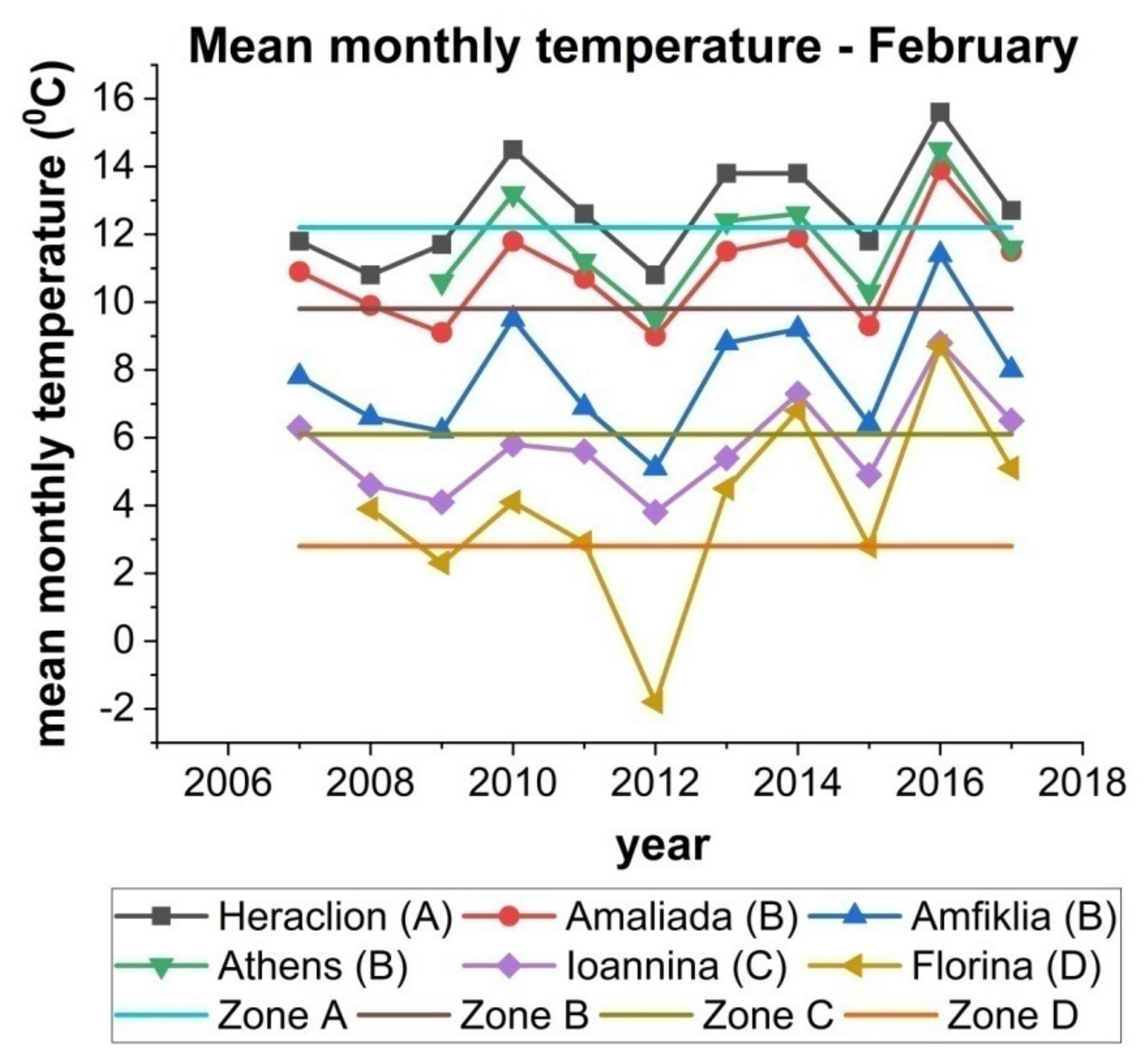

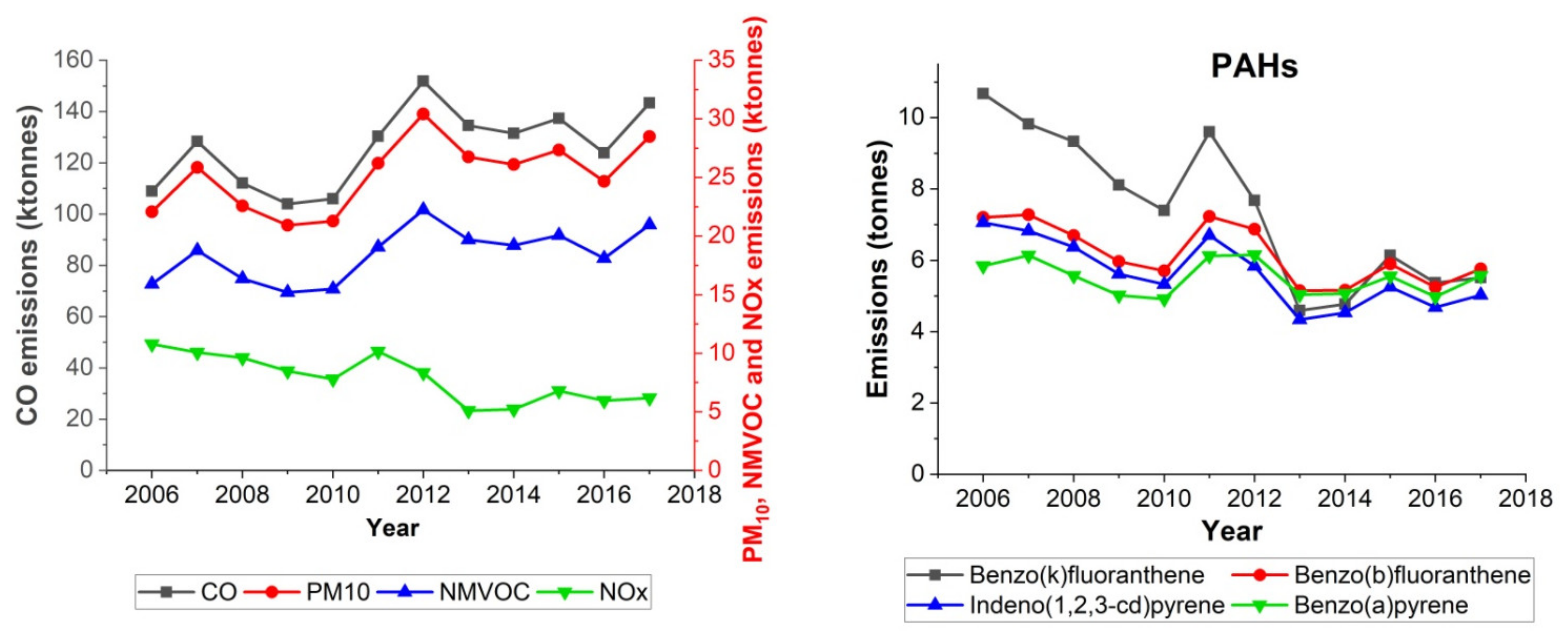

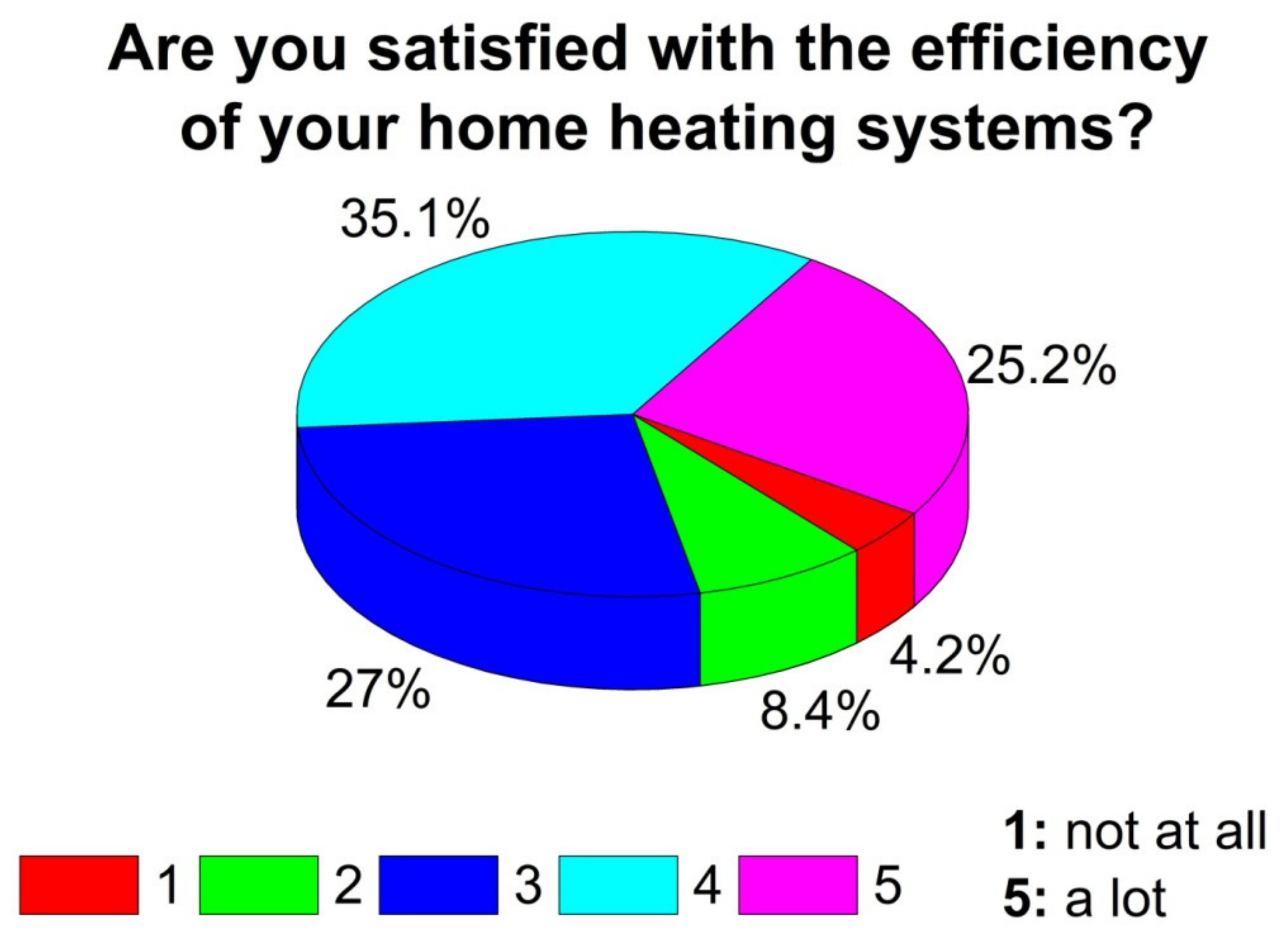
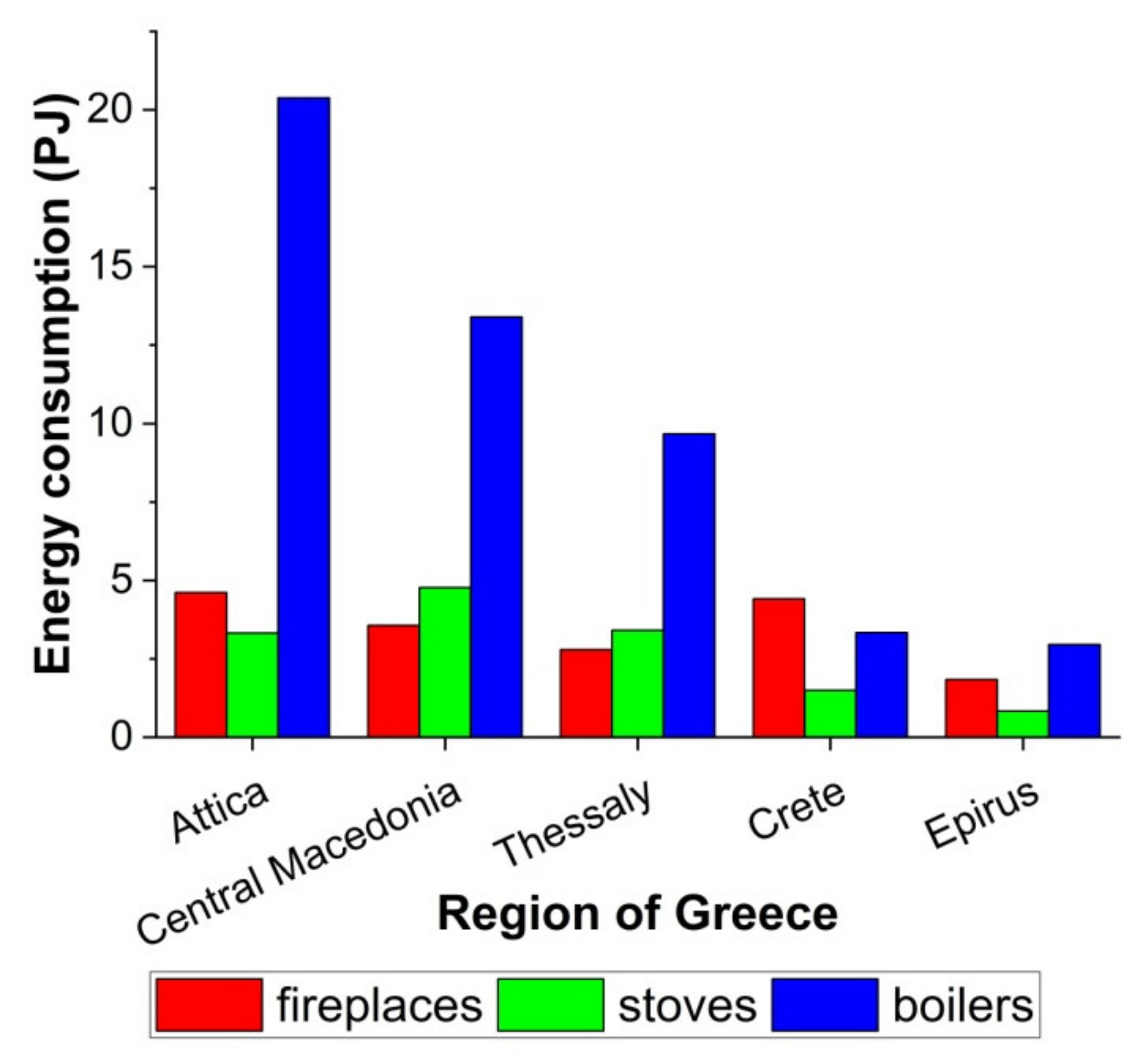
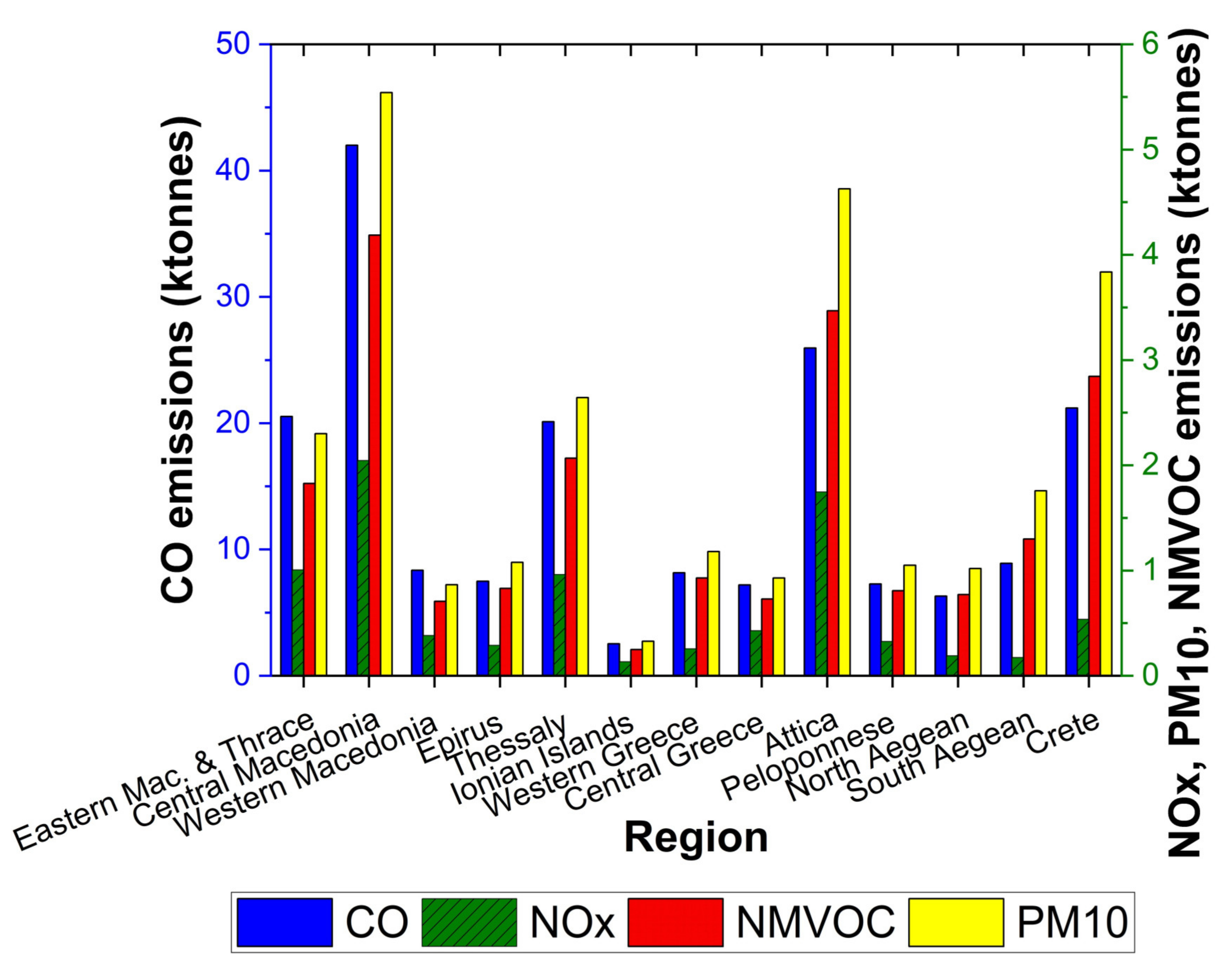
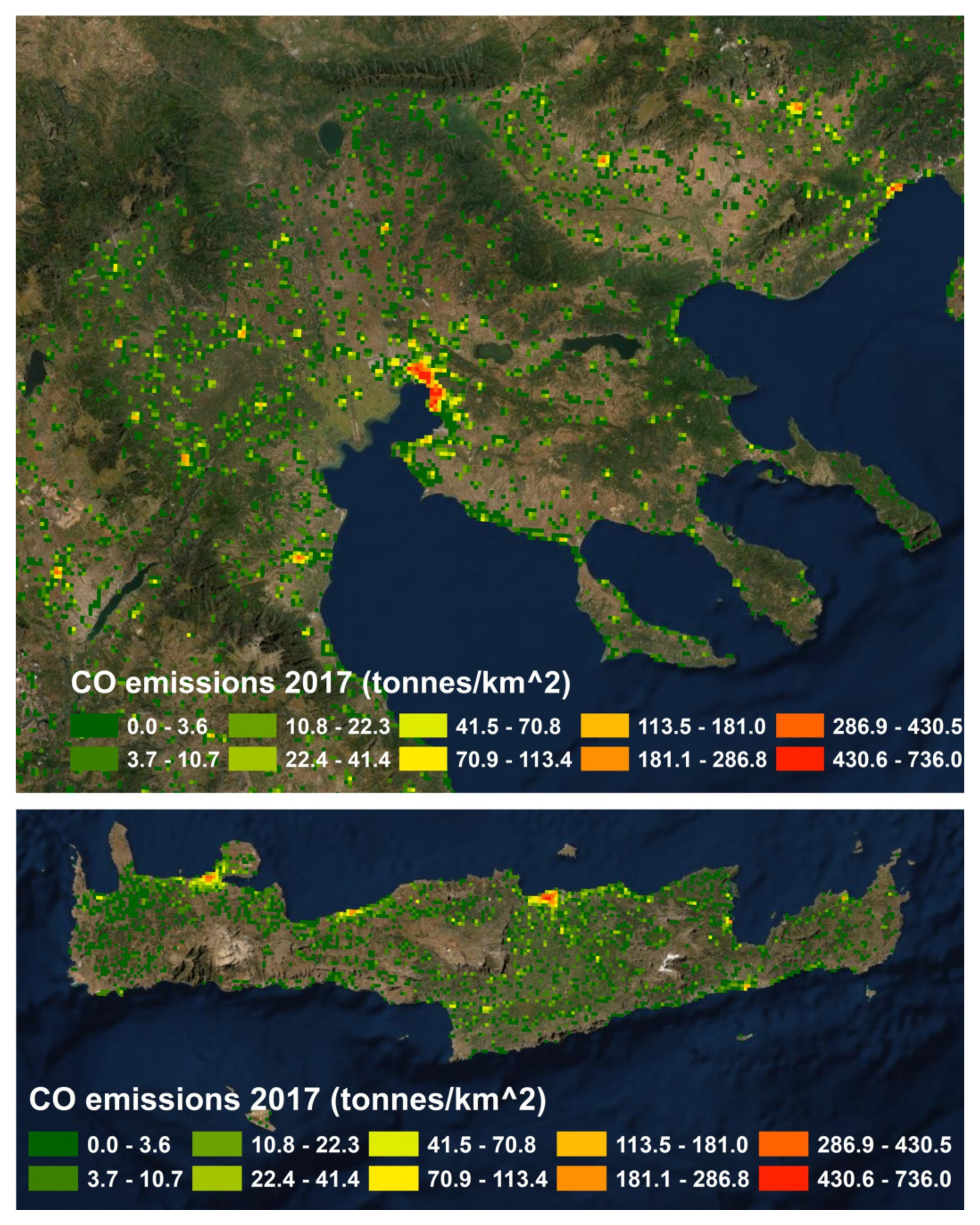

| Zone | Boiler | Air Condition & Electric Radiators | Fireplace | Stove | Other | Total Number of Responses per Region | |
|---|---|---|---|---|---|---|---|
| Crete | A | 65.17% (58) | 20.22% (18) | 10.11% (9) | 3.37% (3) | 1.12% (1) | 89 |
| South Aegean | A | 54.17% (13) | 29.17% (7) | 4.17% (1) | 8.33% (2) | 4.17% (1) | 24 |
| Peloponnese | A (& B) 1 | 60.00% (21) | 22.86% (8) | 5.71% (2) | 11.43% (4) | 0.00% (0) | 35 |
| Ionian Islands | A & B 2 | 53.85% (7) | 15.38% (2) | 30.77% (4) | 0.00% (0) | 0.00% (0) | 13 |
| Attica | B | 69.15% (390) | 20.39% (115) | 3.01% (17) | 6.38% (36) | 1.06% (6) | 564 |
| North Aegean | B | 57.14% (8) | 7.14% (1) | 21.43% (3) | 14.29% (2) | 0.00% (0) | 14 |
| Western Greece | B | 61.65% (82) | 20.30% (27) | 6.77% (9) | 10.53% (14) | 0.75% (1) | 133 |
| Central Greece | B (& C) 1 | 70.97% (22) | 12.90% (4) | 6.45% (2) | 6.45% (2) | 3.23% (1) | 31 |
| Epirus | B & C 2 | 72.97% (27) | 18.92% (7) | 5.41% (2) | 0.00% (0) | 2.70% (1) | 37 |
| Central Macedonia | C | 73.08% (76) | 14.42% (15) | 4.81% (5) | 5.77% (6) | 1.92% (2) | 104 |
| Thessaly | C (& B) 1 | 82.43% (61) | 1.35% (1) | 8.11% (6) | 8.11% (6) | 0.00% (0) | 74 |
| East Mac.&Thrace | C (& D) 1 | 55.88% (19) | 20.59% (7) | 5.88% (2) | 11.76% (4) | 5.88% (2) | 34 |
| Western Macedonia | D | 76.92% (10) | 7.69% (1) | 0.00% (0) | 7.69% (1) | 7.69% (1) | 13 |
| Total | 794 | 213 | 62 | 80 | 16 | 1167 |
| 6:00–8:00 | 8:00–10:00 | 10:00–12:00 | 12:00–14:00 | 14:00–16:00 | 16:00–18:00 | 18:00–20:00 | 20:00–22:00 | 22:00–24:00 | |
|---|---|---|---|---|---|---|---|---|---|
| Weekday | 0.156 | 0.107 | 0.088 | 0.083 | 0.097 | 0.107 | 0.123 | 0.139 | 0.102 |
| Saturday | 0.154 | 0.107 | 0.086 | 0.085 | 0.100 | 0.107 | 0.122 | 0.133 | 0.106 |
| Sunday | 0.155 | 0.107 | 0.085 | 0.084 | 0.102 | 0.108 | 0.122 | 0.133 | 0.105 |
Publisher’s Note: MDPI stays neutral with regard to jurisdictional claims in published maps and institutional affiliations. |
© 2021 by the authors. Licensee MDPI, Basel, Switzerland. This article is an open access article distributed under the terms and conditions of the Creative Commons Attribution (CC BY) license (https://creativecommons.org/licenses/by/4.0/).
Share and Cite
Fameli, K.-M.; Papagiannaki, K.; Kotroni, V. Optimizing the Knowledge on Residential Heating Characteristics in Greece via Crowd-Sourcing Approach. Atmosphere 2021, 12, 1178. https://doi.org/10.3390/atmos12091178
Fameli K-M, Papagiannaki K, Kotroni V. Optimizing the Knowledge on Residential Heating Characteristics in Greece via Crowd-Sourcing Approach. Atmosphere. 2021; 12(9):1178. https://doi.org/10.3390/atmos12091178
Chicago/Turabian StyleFameli, Kyriaki-Maria, Katerina Papagiannaki, and Vassiliki Kotroni. 2021. "Optimizing the Knowledge on Residential Heating Characteristics in Greece via Crowd-Sourcing Approach" Atmosphere 12, no. 9: 1178. https://doi.org/10.3390/atmos12091178
APA StyleFameli, K.-M., Papagiannaki, K., & Kotroni, V. (2021). Optimizing the Knowledge on Residential Heating Characteristics in Greece via Crowd-Sourcing Approach. Atmosphere, 12(9), 1178. https://doi.org/10.3390/atmos12091178








